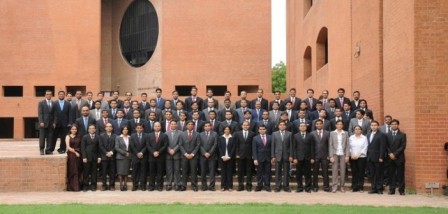


Planning to apply to IIM A’s One Year MBA (PGPX)? Then this page should be your Bible/ Gita/ Quran. The elves at OneYearMBA.co.in dug deep this Christmas and pulled out an all Class comparison for the last 9 Classes of the PGPX.
Below you will find a comparison between all past Classes of the PGPX on critical parameters such as applications received, applicants called for interviews, average GMAT, work experience and more.
Key Highlights
| PGPX: All Batch Comparative Stats | |||||||||
| Parameter | PGPX-I (2006-07) | PGPX-II (2007-08) | PGPX-III (2008-09) | PGPX-IV (2009-10) | PGPX-V (2010-11) | PGPX-VI (2011-12) | PGPX-VII (2012-13) | PGPX-VIII (2013-14) | PGPX-IX (2014-15) |
| Total Applications received | 773 (F 34) | 849 (F 40) | 1352 (F 122) | 1323 (F 86) | 982 (F 73) | 908 (F 63) | 942 (F 93) | 661 (F 93) | 690 (F 67) |
| Called for Interviews | 232 | 328 | 325 | 366 | 246 | 244 | 251 | 247 | 230 |
| Attended Interviews | 208 | 313 | 299 | 330 | 228 | 220 | 243 | 238 | 216 |
| Batch Size | 60 | 72 | 78 | 80 | 86 | 101 | 85 | 85 | 85 |
| Female | 5 | 4 | 9 | 2 | 6 | 6 | 6 | 12 | 13 |
| International Students | 6 | 8 | 9 | 8 | 6 | 7 | 6 | 12 | 3 |
| Residing Abroad (5 to 8 countries) | 25 | 21 | 21 | 20 | 36 | 40 | 31 | 24 | 21 |
| Higher Degree Holders (Master’s, Professional) | 30 | 35 | 43 | 35 | 42 | 45 | 37 | 37 | 34 |
| Engineers | 49 | 51 | 58 | 56 | 55 | 82 | 65 | 68 | 71 |
| IIT / NIT graduates | 17 | 23 | 13 | 17 | 25 | 28 | 20 | 20 | 18 |
| GMAT | 699 | 695 | 728 | 721 | 712 | 714 | 717 | 711 | 705 |
| Age | 32 | 33 yrs | 33 yrs | 33 yrs | 33 yrs | 34 yrs | 34 yrs | 34 yrs | 34 yrs |
| International Work Exp | 3 yrs 4 m | 3 yrs | 4 yrs 6 m | 4 yrs 9 m | 4 yrs 4 m | 4 yrs 7 m | 3 yrs 2 m | 3 yrs 3 m | 3 yrs 0 m |
| Total Work Experience | 9 yrs | 9 yrs | 10 yrs | 10 yrs | 10 yrs | 10 yrs | 10 yrs 5 m | 10 yrs 2 m | 9 yrs 8 m |
| Sector Profile(%) | |||||||||
| BPO | 0 | 0 | 1 | 3 | 1 | 2 | 3 | 1 | 0 |
| Energy/Power | 0 | 3 | 2 | 0 | 1 | 4 | 1 | 4 | 8 |
| Financial Service | 5 | 8 | 3 | 11 | 7 | 10 | 7 | 11 | 9 |
| FMCG | 1 | 3 | 1 | 1 | 4 | 0 | 0 | 0 | 3 |
| Govt. Engg. | 0 | 0 | 0 | 0 | 1 | 1 | 0 | 0 | 0 |
| Govt. Services | 2 | 2 | 0 | 2 | 1 | 1 | 2 | 4 | 2 |
| Healthcare | 0 | 0 | 1 | 2 | 4 | 4 | 0 | 1 | 4 |
| IT and IT Services | 30 | 35 | 45 | 35 | 43 | 51 | 34 | 29 | 28 |
| Management Consultancy | 0 | 1 | 3 | 1 | 2 | 3 | 7 | 6 | 2 |
| Manufacturing Engg. | 6 | 1 | 4 | 3 | 4 | 8 | 9 | 5 | 13 |
| Media | 1 | 1 | 1 | 0 | 2 | 0 | 1 | 2 | 1 |
| Projects/Design/ Construction | 1 | 0 | 1 | 2 | 4 | 1 | 0 | 0 | 0 |
| Retail | 0 | 0 | 0 | 0 | 1 | 2 | 1 | 2 | 0 |
| Shipping | 2 | 1 | 2 | 3 | 2 | 1 | 0 | 1 | 0 |
| Telecom | 3 | 5 | 6 | 10 | 8 | 8 | 6 | 4 | 5 |
| Airline/Travel | 0 | 1 | 0 | 1 | 0 | 0 | 1 | 2 | 0 |
| Hospitality Services | 0 | 0 | 0 | 1 | 0 | 0 | 0 | 1 | 0 |
| Manufacturing Process | 7 | 8 | 3 | 4 | 0 | 3 | 2 | 3 | 3 |
| Infrastructure | 0 | 0 | 0 | 0 | 0 | 0 | 6 | 2 | 1 |
| Defence | 2 | 3 | 5 | 1 | 1 | 1 | 4 | 4 | 1 |
| Education | 0 | 0 | 0 | 0 | 0 | 0 | 1 | 0 | 1 |
| NGOs | 0 | 0 | 0 | 0 | 0 | 1 | 0 | 3 | 1 |
| Law | 0 | 0 | 0 | 0 | 0 | 0 | 0 | 0 | 2 |
| Industrial/Process Automation | 0 | 0 | 0 | 0 | 0 | 0 | 0 | 0 | 1 |
| Total | 60 | 72 | 78 | 80 | 86 | 101 | 85 | 85 | 85 |
2 Comments
Regarding Acceptance ratios for 2 year programs, given that you can apply for free (or a nominal amount), the ratio can be reworked to:
Number of acceptances / Number of people who wrote the qualifying exam
Using this metric, you would have an acceptance ratio in Harvard (arguably the most sought after business program) of:
Number of admits / Number of people who wrote the GMAT
That is approximately 900 / 238,000 = 3.8%
http://www.hbs.edu/recruiting/mba/data-and-statistics/class-profile.html
3.8% is still an order of magnitude higher than the acceptance rate for the top 2 year programs in India. It would be interesting to see how many people would apply for CAT if they knew that they would need a minimum of 2 years of experience to be accepted. Cultural nuances and difference in acceptance criteria are difficult to adjust for.
you have hit the nail on the head senthil